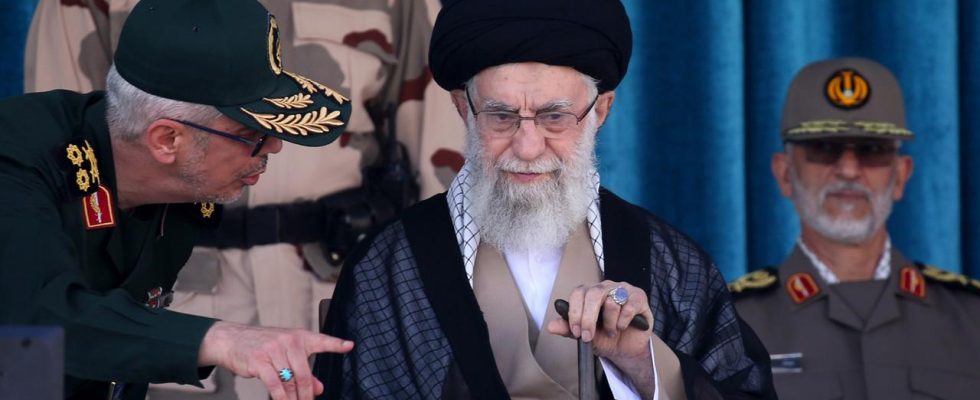analysis
To the outside world, Tehran appears strong and willing to fight. But a look inside the Islamic Republic reveals that the regime’s greatest enemy is its own population.
There was no shortage of pithy words or grand gestures around the celebrations for the 45th anniversary of the Islamic Revolution. At the obligatory demonstrations, to which the regime specially busses its ever-decreasing supporters, the classic slogans “Death to America” and “Death to Israel” could be heard, as could the hymns of praise for the “Axis of the Axis” that have been heard for weeks resistance” and their fight against Israel.
In addition, the mullahs’ opponents were once again told what they have already heard several times from Tehran in recent weeks: that if an attack on its territory occurs, the Islamic Republic will not hesitate to “use its ability to respond “which leads to remorse among the aggressors”. So clear words.
Vulnerability greater than claimed
However, anyone who takes a closer look at the country will find that its strength is nowhere near as great as the regime’s representatives would have you believe. In recent weeks, the Iranian Revolutionary Guards have had to mourn the loss of several important members. On December 25th, Rasi Mousavi, general of the Quds Force, was killed in a targeted airstrike in Syria – as were four other military advisors, including two senior intelligence officers, on January 20th.
In addition, the serious explosions carried out by the terrorist group IS in Kerman on January 3rd, which left more than 90 dead, as well as the unexpected skirmishes with Pakistan at the end of January, made it clear that both Iran’s internal security and air defense have deficiencies.
There is less and less support among citizens
But the real problem facing the Iranian rulers is that they have increasingly less support among the country’s citizens. Since the months of nationwide protests following the death of the Kurdish woman Jina Mahsa Amini in September 2022, it has become clear that the Islamists at the top of the state are ruling against the majority of their own population. The use of violence to maintain their power has now become the norm.
How great the people’s antipathy towards the regime is will become clear on March 1st. Then the Iranian parliament and the Council of Experts will be re-elected, and there are increasing signs that participation in the ballot, which the country’s spiritual and political leadership likes to declare as approval of the political system, is likely to reach a historic low.
Many want to boycott elections in March
Already at the beginning of December, there were indications that large parts of the population would boycott the elections. At the end of January, the news site Khabar-Online published the survey results from an unnamed government organization, presumably the Interior Ministry: According to this, only a maximum of 30 percent of Iranians nationwide want to take part in the ballot.
The forecast for the province of Tehran is 22 percent, and for the capital itself it is only 15 percent. The latter in particular is likely to cause a problem for the country’s image. When voting takes place within the metropolis, foreign journalists usually have the opportunity to visit selected polling stations in order to get an idea of voting in the Islamic Republic. While the juicy poll report in Khabar disappeared after a day, reports circulated that there were demonstrations in some cities where citizens called for a boycott of the elections.
“We are used up”
In addition, critical tones were repeatedly heard from people who are close to the political system. For example, Gholamali Radjaii, an advisor to former President Ali Akbar Hashemi-Rafsandjani, explained on the TV channel Didar-News that “certainly 70 to 75 percent” of the population rejected the religious-political system in the country: “We will soon be in “We are a minority. We are exhausted. The Islamic Republic no longer offers a future and things cannot continue like this.”
In addition, only a total of 138 candidates were nominated nationwide for the election for the 88 seats of the Council of Experts – mostly very conservative and loyal to the line. Reform forces like ex-President Hassan Rouhani were not even allowed to take part. The background is that the body, which is elected for eight years, has the task of determining the successor to the spiritual leader of the Islamic Republic.
Since Ayatollah Ali Khamenei is already 84 years old and is considered to be in poor health, it is very likely that the new expert council will actually be tasked with this task. Accordingly, it is said, the candidates have already been selected in the spirit of the aged theologian and his Islamist spiritual heritage. The perspective of the Iranian population played no role.
Desire for external enemy?
It is not expected that the large gap between the people and the regime will narrow again in the foreseeable future. This may also be a reason why Iran does not actively intervene in the military conflicts between Israel and Hamas. The rulers in Tehran have no popular support for such a step.
Paradoxically, the only way the regime would get its citizens back on its side would be if Iran were attacked. Then the entire country would be able to unite against a common external enemy – as happened in the war against Iraq from 1980 to 1988. But neither the USA nor Israel will probably do this “favor” for the mullahs.

